#Shalom Singer
Explore tagged Tumblr posts
Text
They just don’t understand the peculiar artistic value of my mind and beauty
#whisper girl#2014 tumblr#female hysteria#girl interrupted#girlblogging#lana del rey#girl blogger#manic pixie dream girl#alana champion#im just a girl#randomcokegirlyrambling 𓈒ㅤׂ 𝜗𝜚#hysteric glamour#girl hysteria#messy girl#kate mess#this is what makes us girls#female manipulator#girl blog aesthetic#lizzy grant#gone girl#glitter#vivienne westwood#helena bonham carter#marla singer#tim burton#angelina jolie#shalom harlow#kate moss
13 notes
·
View notes
Text
It seems very fitting that the first prayer I could actually recognize and sing along with on a playlist was Oseh Shalom. It's such a simple and beautiful prayer
#jumblr#jew by choice#jewish conversion#personal thoughts tag#oseh shalom is one of my favorites (this is a lie in that pretty much all of them are my favorite in some way)#but when we sing/pray oseh shalom in shul i love the call and response format and the simpleness - we ask only for peace from g-d#that g-d may make peace for us and for israel. may there be peace. it's fitting that this is what i recognized first i think#and the song on the playlist was very good. it was such a nice composition and i loved how the singers voices sounded#i'm actually excited about this. there's hope for me! i can remember prayers i just have to work on it!! there is hope i can remember them🙏#and frankly that's all i can ask g-d for right now. please just make this learning curve less curvy (joking)
17 notes
·
View notes
Text
"Ocho kandelicas" canción sefardí de Januka by Chiara (doublebass) & Caterina(soprano)" en YouTube
youtube
My sister and I recorded this famous Sephardic song about Chanukah. I hope you like it! 🤗❤️🕎🎶
#Youtube#jumblr#januka#ochokandelicas#ladinosong#sephardim#sephardi jewish#double bass#singer#sisters#shalom#rosh jodesh#rosh chodesh#jewish musicians#musicians
14 notes
·
View notes
Text
⟡ . WHAT KIND OF CELEBRITY WOULD THE GIRLS BE?




☆ . model
๋✧˚ · . expect them to appear in countless magazines, see them at the met gala and red carpet. they're the ones who easily catch people's eye
— eula, NINGGUANG, dehya, yelan, KAFKA, LA SIGNORA, raiden ei, himeko, countess chelsea, yukong, shalom, CABERNET, BLACK SWAN, aponia, raiden mei, chameleon
☆ . idol/singer
๋✧˚ · . you'll be seeing lots of edits of them everywhere on social media. they're the internet sensation, and everyone's newfound music taste
— keqing, ganyu, SERVAL, yoimiya, ayaka, EDEN, kiana, NILOU, BARBARA, kirara, XINYAN, march 7th, ELEVEN, ROBIN
☆ . actress
✧˚ · . they never fail to grasp your attention in a show or movie. you've seen them alot of times, and they have millions of fans fawning over them
— YAE MIKO, clorinde, TINGYUN, furina, eirene, coquelic, topaz, lisa, jean, RUAN MEI, fu xuan, navia, elysia

© 𝗮𝗹𝗹 𝘄𝗼𝗿𝗸𝘀 𝗰𝗿𝗲𝗮𝘁𝗲𝗱 𝗯𝘆 𝗲𝗲𝘂𝗹𝘆𝘀𝗶𝗮𝗻. 𝗽𝗹𝗲𝗮𝘀𝗲 𝗱𝗼 𝗻𝗼𝘁 𝘀𝘁𝗲𝗮𝗹, 𝗿𝗲𝘄𝗿𝗶𝘁𝗲 𝗼𝗿 𝗿𝗲𝗽𝗼𝘀𝘁.
#genshin impact#honkai impact#honkai star rail#path to nowhere#genshin impact headcanons#hsr headcanons#ptn headcanons#hi3 headcanons#yae miko x reader#ningguang x reader#dehya x reader#raiden ei x reader#eula x reader#furina x reader#navia x reader#clorinde x reader#himeko x reader#coquelic x reader#serval x reader#nilou x reader#tingyun x reader#yukong x reader#yelan x reader#kafka x reader#shalom x reader#march 7th x reader#fu xuan x reader#wlw#sapphic
298 notes
·
View notes
Text
Jewish Song of the Day #10:
youtube
Comments:
This is a version of a very famous song by the very famous Jewish singer Matisyahu: One Day
This version is done by Koolulam, which gathers huge numbers (in this case thousands) of people together to sing and therefore to be in community with one another
One Day is already a song about peace, but this version sharpens the point even further by having it sung not just in English, but also in Hebrew and Arabic
This song originally made me cry the first time I came upon it, and then a second time when I rediscovered it shortly after the start of the pandemic and the idea of 3000 people singing in a room together was heartbreakingly unimaginable.
Shout-out to @acleverforgery for reminding me about this song now, when it made me cry a third time for yet another reason ❤️
Shabbat shalom, may it truly be a Shabbat of peace!
111 notes
·
View notes
Text
Schiaparelli’s ‘Inferno’: A journey to Hell and back
I’ve always wondered if today’s self-absorbed creative directors and edgy designers at the leading luxury fashion houses based in Paris are familiar with George Santayana’s cutting observation that, “Fashion is something barbarous, for it produces innovation without reason and imitation without benefit.” On the evidence of this year’s Paris Fashion Week I think not.
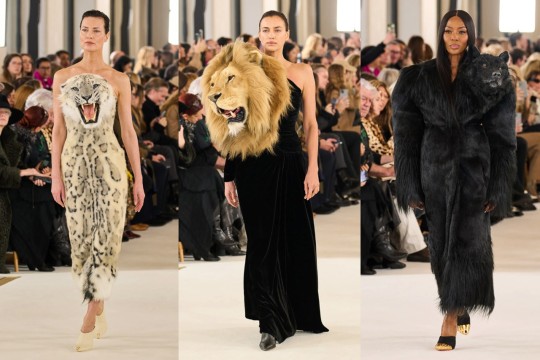
For the Spring 2023 collection at Paris Fashion Week, Schiaparelli creative director Daniel Roseberry revealed in pre-show notes that he was specifically drawn to Dante Alighieri’s magisterial Divine Comedy. He was especially inspired by Inferno, the 14th-century Italian poet’s renderings of Hell. Present as spectators and models were some of the internet’s favourite muses, such as Kylie Jenner wearing taxi-dermied outfits with hyperrealistic faux animal heads affixed to a fitted gown.

The singer Doja Cat was also there, appearing bald and covered in red gemstones at the steps of the Petit Palais like a demonic red figure. In other pieces, gold-painted torsos and metallic sculptural heads paid tribute to the house’s founder, Elsa Schiaparelli, and her ties to Surrealist artists like Man Ray, Salvador Dalí, and Meret Oppenheim during the 1930s. She was the subject of a recent retrospective at the the Musée des Arts Décoratifs in Paris last year in 2022, and her collaborations with those artists demonstrated a propensity to shock audiences with strange garments that at times merged human bodies with animal features.
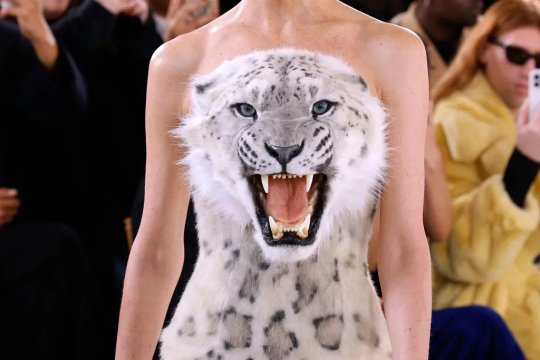

Throughout the haute couture show, Roseberry brought to life versions of Dante’s epic poem’s three allegorical animals: the lion, the leopard, and the she-wolf. Accordingly he dressed three super models, Shalom Harlow as the leopard, Naomi Campbell as the she-wolf, and Irina Shayk as the lion. All three haute couture dresses were sculpted and embroidered by hand, “celebrating the beauty of nature and guarding the woman who wears it” said the proud creative director.
When I read that particular remark I almost choked on my tea. I was sitting in a nearby Parisian café with my younger sister, who was visiting me in France, and one of our French-Nordic cousins who actually works in the luxury brand corporate world as a senior exec in LVMH. Through our cousin we had managed to see one or two of the fashion shows last week. It’s not really my cup of tea, but I gave in to indulge my visiting sister and my cousin who loves her job.
Many people outside of haute couture world of Paris Fashion Week, focused on the spectacle of cruelty of seeing three stuffed animal heads on the bosoms of three super models strutting on a fashion show runway. Most of the criticism was misplaced as it showed little understanding what a haute couture show is all about. It allows the talented designer to let his/her hair down and show off their most off the wall ideas, and above it’s meant to be playful.
That said, I, however, was focused on what Daniel Roseberry actually said of his collection. I thought it was a misquote but no, as it turned out later, it’s what the designer said.
I resisted the urge to feel ‘offended’ and to look around for a pitch fork to join the unruly easily offended mob to denounce the designer. To me it wasn’t about the Surrealist heritage of Schiaparelli that the creative director drew inspiration from for one part of his show - that’s what one might expect from that fashion house. Nor was it the animal depiction on dress gowns that was pretty par for course for any haute couture fashion show - which I personally found garish and in bad taste - but which drew the public outcry against the perception of animal cruelty.
No, it was the crime of cultural vandalism against Dante himself.

I have no idea if Roseberry has actually read the Dante’s Divine Comedy or not but from his remarks that his hideous creations were “celebrating the beauty of nature and guarding the woman who wears it” he clearly hadn’t or was high as a kite on drugs and high energy drinks.
So I’m going to discuss Dante’s three wild beasts as Dante wrote them.
In the opening Canto of the Divine Comedy, Dante encounters three ferocious animals: the leopard, the lion and the she-wolf.

In the first canto of the Inferno, Dante, having gone astray in a dark wood, reaches the base of a sunlit hill (later described by Virgil as “the mountain of delight, the origin and cause of every joy”) and begins to climb - only to find the way blocked by three beasts. First, a leopard appears.
And almost where the hillside starts to rise - look there! - a leopard, very quick and lithe, a leopard covered with a spotted hide. He did not disappear from sight, but stayed; indeed, he so impeded my ascent that I had often to turn back again.
It is a spring morning, and “the hour and the gentle season” give Dante “good cause for hopefulness” upon seeing the leopard - but then he sees a lion.
but hope was hardly able to prevent the fear I felt when I beheld a lion. His head held high and ravenous with hunger - even the air around him seemed to shudder - this lion seemed to make his way against me.
When the third beast appears, Dante gives up hope entirely.
And then a she-wolf showed herself; she seemed to carry every craving in her leanness; she had already brought despair to many. The very sight of her so weighted me with fearfulness that I abandoned hope of ever climbing up that mountain slope. . . . I retreated down to lower ground.
When you read Dante - in Italian or in translation - nothing you read ever so simple and nothing should be taken at face value. Indeed in the Divine Comedy almost nothing is said without good reason. Take the verse preceding the appearance of the three beasts.
When I had rested my body there a while I then started again up the barren slope the more powerful foot always behind the other
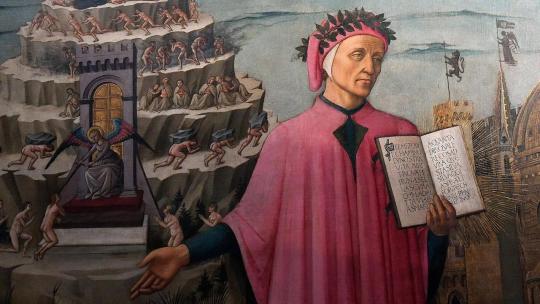
Dante refers to the manner of his climb. He makes the climb with ‘the more powerful foot always behind the other’. One foot (the more powerful) is always behind (lower than) the other. This is a difficult line to interpret. It could of course simply be a description of how someone climbs a hill. You plant one foot in the ground and then push up allowing the other foot to 'land' and secure your position.
If Dante is talking about a stronger (firmer) foot and (presumably then) a weaker foot and talks about the one being lower than the other, there is probably a deeper meaning behind it. In Dante's thought world it was sometimes said that in the 'pilgrimage' towards heaven, we walk on two 'feet' (or legs); the Will and the Intellect. Because the Will, the stronger of the two, is always desiring what it shouldn't, our journey forward towards God is therefore hampered. We limp our way to heaven! So Dante could be saying that his Will lags behind his Intellect as he strives to find the light of God, making his journey up those slopes that much harder. The (weaker) Intellect is having to drag the (stronger) Will upwards towards the divine light.
An alternative explanation is inspired by a comment from St Augustine to the effect that 'love is the foot of the soul', in other words the driving force of the soul's quest for God. So, Dante could be suggesting that his stronger foot (love) pushes his body up the hill towards God. Personally I prefer this more optimistic image of his ascent; after all, he begins his climb in hope and anticipation.
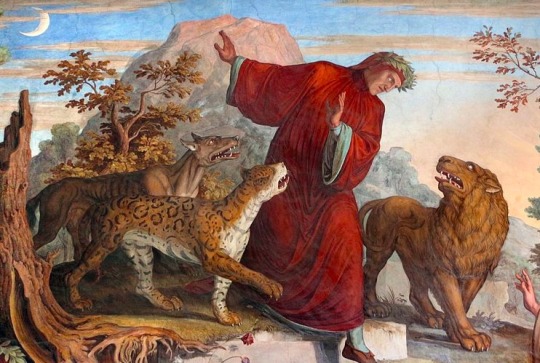
And so we have to ask ourselves as we come to the three beasts, is there a deeper meaning to these animals beyond their physical power and scariness. Yes, there is.
When Dante engages with myths throughout his Inferno, he’s also leaning into this tradition of animals as allegories. He’s striving to teach a lesson, as mythical creatures punish sinful souls for eternity. Invoking creatures from antiquity, Dante’s Inferno moulds pagan hell into a Christian design. These mythical creatures are behemoth reminders for potential sinners about the consequences of their actions.
Even from the opening canto of Dante’s Inferno, we find our titular character lost in a dark and winding wood. As the woods darken, he feels his consciousness enter a strange state - a feeling that he likens to death (Inferno 1.7). As this shroud covers him, Dante encounters the first mythical creatures in the Divine Comedy. Leopards and lions were not native to Italy. Travellers relayed tales of these beasts to illuminators and scribes, and information about them would be published in bestiaries. Leopards were often incorporated into coats of arms when there were descendants of adultery in a lineage. The leopard Dante encounters is “very quick and lithe” (Inferno, 1.32). Perhaps the leopard is meant to symbolise a sin associated with impatience or hubris. Lions were often symbols of Christ, akin to Aslan in the Chronicles of Narnia but in this case the lion was “ravenous with hunger” (Inferno 1.46), which may have been a reminder to the reader about the dangers of gluttony.
The importance of animals goes beyond face value. Animals appearing in stories always contain allegories. The beasts symbolised the major categories of sin: incontinence, violence and fraud. Or as they are more commonly called - lust, pride and avarice. In her commentary, Dorothy L. Sayers explains that these categories of sin were associated with the three stages of life - lust with youth, pride (self-conceit) with the middle years and avarice with old age. Of course, they can attack a person at any time of his life.
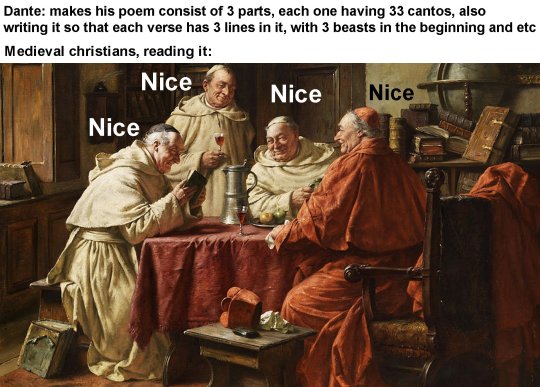
Symbolism can help us enormously when reading Dante but it is also important I think to try to read the text itself and take clues from the way Dante uses the symbols. The Leopard is mesmerising, clever, quick and very pleased with itself, displaying its gaudy spots for all the world to see. The Lion terrifies even the air around it with its appearance (and presumably its roar) but the most noticeable thing about it from Dante the pilgrim's point of view is how proud it is as it hold its head up high. The third beast, the she-wolf, is one that has brought grief to many people. Her leanness speaks of an insatiable appetite; no matter how much (or how many people!) she eats she never thrives, never grows fat, she is never satisfied.
If Dante's world each of the beasts represented different vices or sins - the leopard as a symbol of lust, the lion a symbol of violent pride and the she-wolf as a symbol of avarice and fraud - then these could also either represent Dante's own besetting sins which prevent him from reaching heaven, or perhaps the three levels of hell which are divided according to the kind of sin committed. In the first circle Dante the pilgrim will find those guilty of avarice and incontinence (not the bowel kind), in the second circle sinners guilty of violence and in the third, those responsible for crimes of treachery and fraud.

It’s easy to see then these animals as symbols of divine judgement on Dante. Dante is not ready to find the divine light. He is still under judgement. His sins have not been dealt with and as we shall learn, only by descending to hell and rising through the mountain of purgatory will he be able to find that light as a 'saved' soul.
All three wild beasts are mentioned in the bible and used as symbols of the kind of fate that will befall the people of God as divine judgment.
In Hosea 13:4-8 God says that he will be like a lion and a leopard (and an angry mother bear!) towards his ungrateful, apostate people.
In Jeremiah 5.1-6, Jeremiah fails to find one godly (just) person in the city of Jerusalem. Failing to do so God promises that judgement will come like this:
Therefore a lion from the forest will attack them, a wolf from the desert will ravage them, a leopard will lie in wait near their towns to tear to pieces any who venture out, for their rebellion is great and their backslidings many. (NIV)
If indeed the wild beasts represent the judgement of God in the Old Testament through Hosea and Jeremiah, in the New Testament they take another form entirely. And this may well have played a part in Dante’s thought. It is entirely possible that Dante is thinking of the Apostle Paul's reference to 'fighting wild beasts in Ephesus' (1 Corinthians 15.32). Of course Paul didn't mean he actually wrestled lions and wild beasts. He meant that dealing with those who opposed him there was just like being a gladiator in the arena fighting lions and bears. And the people who opposed him were the institutions of Ephesus, the city authorities, the trade guilds, the business leaders.
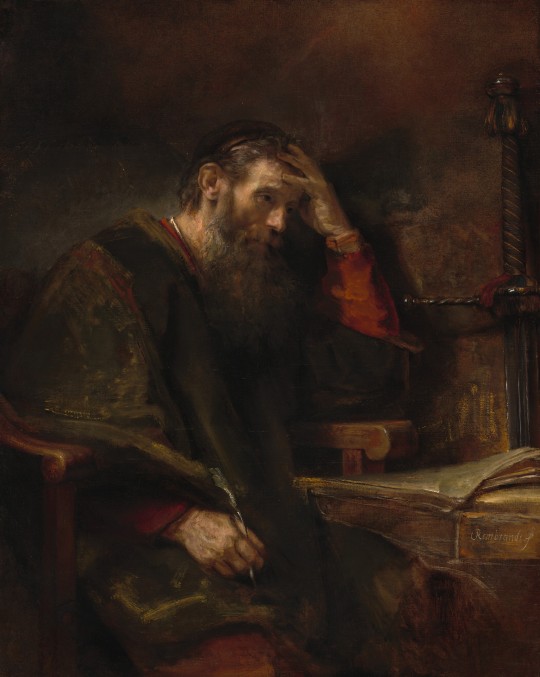
Dante the pilgrim, following in the footsteps of the Apostle struggles with his own 'wild beasts'. the wild beasts who had plotted against him, and exiled him from his native city in 1302. Dante the pilgrim walks in the footsteps of Paul. He also walks in the footsteps of Christ who was alone in the wilderness with the wild beasts for 40 days and 40 nights. Although the the original intention of the gospel writers may have been to conjure up the impression of a restored Eden, for Dante those accounts would have conjured up the idea of conflict and danger.
Like Paul and like Christ, Dante the pilgrim has to struggle with ferocious animals in his journey towards God, just as Dante the writer has had to in his journey.
Who or what then are these forces, these wild animals who prevented Dante from finding the true path? Interestingly these animals were all prized in one way or another in Dante's native Florence.
There is evidence that a leopard and a number of lions were kept and publicly displayed in cages in Florence in Dante's day near what is today the Loggia del Bigallo, as a sign of Florence's power and prestige.
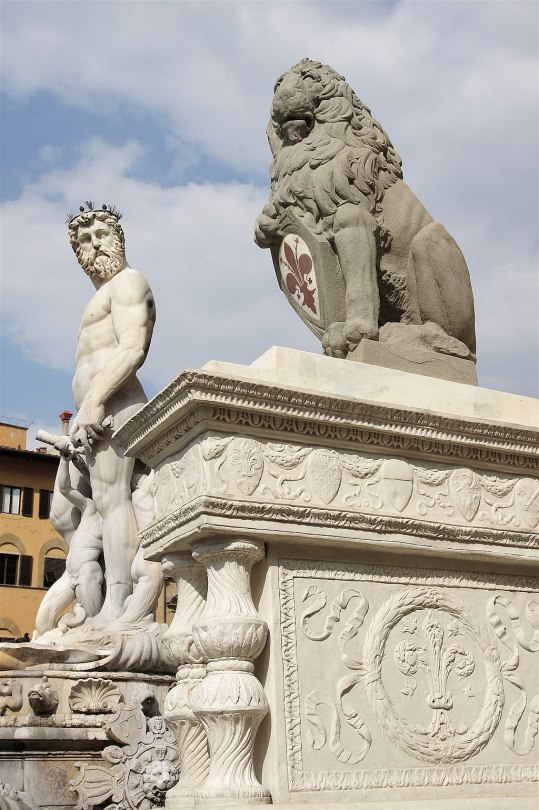
The lion was also part of Florence's coat of arms. Scholars have noted that Dante was familiar with the writings of Richard of St Victor who had associated the leopard with the sins of deceit and fraud. The lion was associated in medieval bestiaries with the sin of avarice (because of its apparently insatiable hunger) as well as with pride. These are 'civic sins' as much as personal vices.
Was it Florence's avarice and pride that was in the front of Dante the writer's mind when he described the leopard's gaudy spots and the lion with its head held high? Is it perhaps the city that had turned against Dante and thrown him out to live a life of exile that prevents the progress of the pilgrim towards paradise?
The she-wolf is the most daunting beast of all. She proceeds terrifyingly, step by step stalking forward, threatening and relentless. Dante comments:
The very sight of her so weighted me with fearfulness that I abandoned hope of ever climbing up that mountain slope. . . . I retreated down to lower ground.
Surprisingly perhaps it is the she-wolf, not the leopard or the lion that finally causes the pilgrim to despair. Wolves were considered to be symbols of fraud and deceit as well as sexual immorality and prostitution.

In his hugely influential work The City of God, St Augustine had commented that in his time prostitutes were known as she-wolves and a brothel was known as a 'wolf den'. He suggested that this verbal link gave rise to the famous origin myth of Rome, according to which the two twins Romulus and Remus, the offspring of the god Mars and the their mother (whom he had raped) Rhea, were abandoned to die but were saved and suckled by a she-wolf. Augustine suggests that instead, they were found and fed by an unknown prostitute i.e. by a 'she-wolf'. From this play on words came the legend that it was a literal she wold who found and fed them. In the City of God (Book 18 chapter 21) Augustine writes as follows:
“Procas ruled before Aemulius. Now Aemulius had made his brother Numitor's daughter, named Rhea, a Vestal Virgin; she was also called Ilia, and was the mother of Romulus. The Romans wish to say that she conceived twins by Mars; for, in this way, they honoured, or excused, her unchastity. They offer as proof of this the legend that, after their exposure, the infants were suckled by a she-wolf. For they hold that this species of animal belongs to Mars; and so, therefore, the she-wolf is believed to have offered her teats to the little children because she recognised in them the sons of Mars, her master.
There is, however, no lack of people who say that, when the exposed infants lay wailing, they were first taken in by some unknown whore, and that hers were the first breasts they sucked - for ‘she wolves’ (lupae) was the name given to whores, which is why houses of ill repute are even now called ‘wolfouses’ (ilupanaria). Afterwards, it is said, they came into the care of a shepherd called Faustulus, and were nurtured by his wife Acca. And yet if, in order to convict the man who was king, and who had cruelly commanded that these infants be cast into the water, God willed to help the children through whom such a great city was to be founded, and to have them rescued from the water by His divine intervention and suckled by a wild animal: is there anything very wonderful in this? “
- Translated by W. Dyson (Cambridge Texts in the History of Political Thought)
So, according to Augustine, it wouldn't be surprising if God had supplied a real she-wolf to find and feed the abandoned babies, because God is merciful and just, but in fact the stories he has heard suggest a different explanation. Namely that it was a human 'she-wolf', a whore, who had found them.
It is also interesting that Augustine links the god Mars with the story. The wolf, he says, is one of Mars' own creatures' i.e. a beast with a special affinity to Mars. Is it relevant that the city of Florence had adopted Mars as its own patron 'star'? It may also be relevant that the name of the Guelf faction, some of whom had ordered Dante's expulsion from Florence, was linked to the German word for wolf (Welf). Dante's enemies in Florence were 'wolves'. It seems the clue lay in the name.
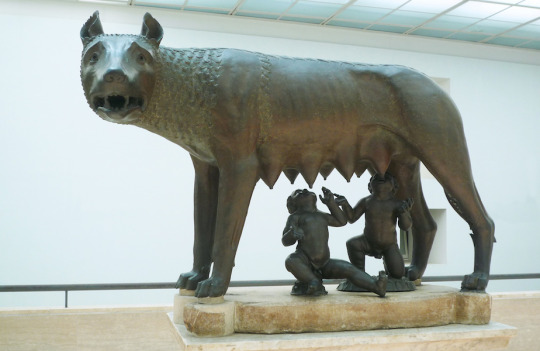
But it may not have been only Florence Dante wanted to suggest to readers' minds. In addition it seems that by the time Dante wrote the Divine Comedy the Papal Curia had adopted as its own symbol the famous statue of Romulus and Remus suckling from the mother she-wolf on the Capitoline Hill. The she-wolf was of course the defining myth of Rome’s founding. Several ancient sources refer to statues depicting the wolf suckling the twins. Livy reports in his Roman history that a statue was erected at the foot of the Palatine Hill in 295 BC. Pliny the Elder mentions the presence in the Roman Forum of a statue of a she-wolf that was "a miracle proclaimed in bronze nearby, as though she had crossed the Comitium while Attus Navius was taking the omens". Cicero also mentions a statue of the she-wolf as one of a number of sacred objects on the Capitoline that had been inauspiciously struck by lightning in 65 BC: "it was a gilt statue on the Capitol of baby being given suck from the udders of a wolf." Cicero also mentions the wolf in De Divinatione 1.20 and 2.47.
The Capitoline Wolf was widely assumed to be the very sculpture described by Cicero, due to the presence of damage to the sculpture's paw, which was believed to correspond to the lightning strike of 65 BC. The 18th-century German art historian Johann Joachim Winckelmann attributed the statue to an Etruscan maker in the fifth century BC, based on how the wolf's fur was depicted. It was first attributed to the Veiian artist Vulca, who decorated the Temple of Jupiter Capitolinus, and then reattributed to an unknown Etruscan artist of around 480 - 470 BC.
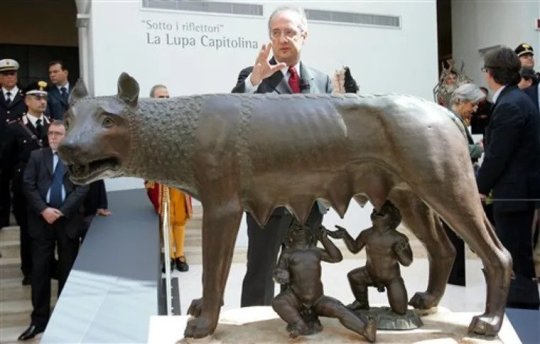
So for centuries The Capitoline Wolf was almost universally recognised as an Etruscan statue from the early part of the 5th century BC. It was only in 2006 that an Italian art historian and restorer, Anna Maria Carruba, published a detailed critique against the accepted view. She argued that the bronze had been cast with a method unknown in classical times, and that marks left by the artist on its surface were more typical of the Middle Ages. Barely a year later in 2007, Rome’s top archaeologist and heritage advisor, Prof. Adriano La Regina, reported that over 20 tests using radiocarbon and thermoluminescence dating don at the University of Salerno suggested that the wolf portion of the statue may have been cast between 1021 and 1153. Overnight one ancient Rome’s oldest artefacts became one of city’s youngest.
Given the pride and place of this famous statue, The Capitoline Wolf, given by the Church of Dante’s time, it adds an extra dimension to any reading Dante’s words about the she-wolf. For the wolf, the creature of Mars, the symbol of Rome and now of the church was a big thing in 13th century Italy. It is this beast that scares Dante the most, that strips away his hope and forces him to turn around. It is this beast he says which has been ‘the despair of many’. It is not a surprise then to find that throughout the Inferno he likens various damned souls to wolves.
Again the bible may have played a part in his thinking Jesus warned his disciples to watch out for the false prophets, the wolves who come dressed in sheep's clothing. Ithink it’s too much of a stretch to say it was a direct attack on the church or the papacy of Boniface VIII but it does lend credence to the possibilities of personal corruption for those in the church who flirted with earthly temptations and sins - the very sins that destroyed souls and blocked humanity’s upward path to heavenly salvation.
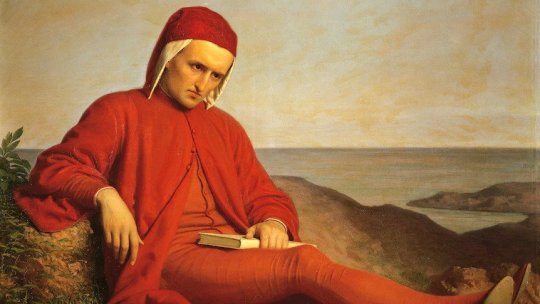
For Dante there was no distinction between the inner and the outer person or between the individual and social. The individual did not live a life apart from his or her wider life in the state and in the church. Sin was something that affected everything and everyone. These beasts may well represent sin or vices with which Dante the writer was only too familiar in his own experience but to me it seems highly likely that they represent above all the forces he saw around him which, in his mínd, prevented people finding the beauty and love of God. The Apostle fought his wild beasts in Ephesus. Dante fought his in Florence.
The mythical figures featured in Dante’s Inferno lean on a long tradition of animals as allegory. As Dante journeys through the realms of the afterlife, these beings can lend a helping hand on the long and winding road through hell, purgatory, and heaven. While the creatures of the Inferno intend to scare sinners straight, they themselves also suffer as the embodiment of their respective sins.
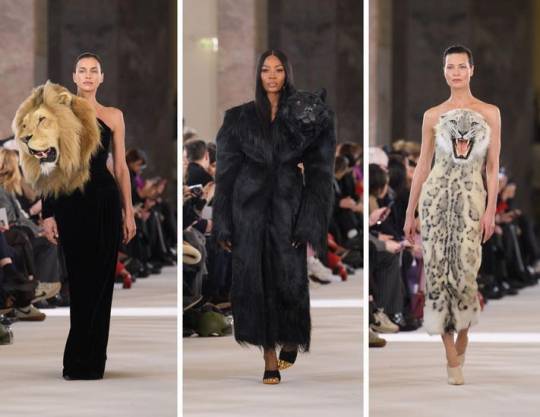
While hell is where sinners languish, it remains a complex and captivating place. Dante filled his entire Divine Comedy with bizarre creatures from across literature, and they serve a similar purpose to any beast in a story: to distill morals or a lesson. Their presence makes the story memorable, even for modern readers like us today.
Dante’s Inferno brings readers on a journey through hell, replete with allegories from across time like sitting through a hellscape of a Schiaparelli haute couture fashion show during Paris Fashion Week. As time wears on, Inferno’s wild beasts offer captivating perspectives on our very modern sins of lust for affirmation, pride in our self-centredness, and an avarice for material comfort.

But I don’t wish to end on a downer because Dante is not a pessimistic poet. Most readers never proceed beyond the macabre thrills of Dante’s ‘Inferno’, with its grotesquely inventive torments. Those who do ascend from the “Inferno” find some of Dante’s most lyrical verse in his ‘Purgatorio’. But it is the least-read of the three books, ‘Paradiso’, that makes sense of the other two. It shows, Dante was not just a poet of crisis, but also a poet of hope:
The ‘Divine Comedy’ is that rarest thing, an epic poem with a hopeful ending. It is about getting a second chance - and ultimately finding joy, a Christian understanding of joy in the light of God’s saving grace.
#essay#dante#dante alighieri#divine comedy#commedia#italian#poem#epic#literature#christian#christianity#church#bible#history#schiaparelli#paris fashion week#paris#paris fashion week 2023#shalom harlow#naomi campbell#irina shayk#supermodels#daniel roseberry#sin#fashio#clothes#haute couture#lion#leopard#she wolf
91 notes
·
View notes
Text
SEPTEMBER 21, 2023 - 6,000 people donate, reportedly including right-wing rabbis, head of ultranationalist Lehava, singer Ariel Zilber; Shalom Hanoch, Aviv Geffen back out of concert with Zilber
A fundraising campaign aimed at freeing from prison a Jewish extremist convicted of killing three members of a Palestinian family in a 2015 arson attack has raised over NIS 1.2 million (over $300,000), with more donations pouring in.
Amiram Ben Uliel was found guilty in 2020 of three counts of murder, two counts of attempted murder, arson, and conspiring to commit a racially motivated crime, as part of a “terrorist act.”
He is serving three life sentences plus 20 years for the firebombing in the West Bank village of Duma, in which Riham and Saad Dawabsha were killed along with their 18-month-old son, Ali Saad. Only the couple’s 5-year-old son, Ahmed, survived the terror attack, with extensive burns.

Palestinians look at the damage after a house was set on fire and a baby killed, allegedly by Jewish terrorists, in the West Bank village of Duma, on July 31, 2015. (AFP/Jaafar Ashtiyeh)

Saad and Riham Dawabsha, with baby Ali. All three died when the Dawabsha home in the West Bank village of Duma was firebombed by Jewish extremists on July 31, 2015 (Channel 2 screenshot)
The drive to have his conviction quashed, titled “Amiram also deserves justice,” gained headlines earlier this week when far-right Otzma Yehudit MK Limor Son Har-Melech spoke at a fundraising event for the campaign, insisting Ben Uliel was innocent and describing him as a “holy righteous man.”
As of Thursday morning, the online crowdfunding campaign had scooped up NIS 1,203,307 ($315,739) from over 6,020 donors.
Among those who have reportedly donated to the campaign are former MK Moshe Feiglin; the head of the ultra-nationalist homophobic anti-Arab Lehava group, Bentzi Gopstein; right-wing singer Ariel Zilber; and far-right rabbis Dov Lior, Elyakim Levanon, and Yehuda Shapira.
#palestine#settler terrorism#israel#zionism#murder#Amiram Ben-Uliel#Ahmed Dawabsha#Ali Saad Dawabshe#settler violence#zionist violence#Duma arson attack#Duma murders#2023#arson#Riham Dawabsha#Saad Dawabsha#Ali Dawabsheh
5 notes
·
View notes
Text
7 things you might have missed at Paris Fashion Week

French style isn't always understated. There was a lot of rain and color at Paris Fashion Week, and even some surprises, including replicas. Here are some of the highlights you may have missed from the week… Sprinkles of rain at Hermès It rained outside the Hermès show at the Garde Républicaine in Paris, but this worked perfectly for creative director Nadège Vanhee-Cybulski, who also brought rain inside the venue. As models walked the runway in riding and ankle-length boots, wearing variations of soft earth tones, including red, brown, grey, and nude tailored coats and skin-tight leather dresses with glossy finishes, an elaborate sprinkler system sprayed them with raindrops. Some garments were even finished with fur, studs, and buckles, proving they were water-resistant. Chloé and Alexander McQueen debut new creative directors. Nothing leaves fashion audiences at the edge of their seats more than when a new creative director makes their debut – especially at a reputable luxury design house. During PFW, a former JW Anderson employee, Dublin-born Sean McGirr, took over from his predecessor Sarah Burton, who made her departure from Alexander McQueen after 20 years. For his debut collection, McGirr gave a nod to McQueen's 1995 spring/summer collection, "The Birds," most evidently in the show's first look. A model was wrapped in a compressed black latex midi dress that almost looked like clingfilm, paired with black heeled boots. Chemena Kamali—an alumna of Saint Laurent—made her creative director debut for Chloé with a collection inspired by the bohemian aesthetics of the 1970s. The collection included blouses with frills, wool capes, faux fur, and trousers with subtle flares. Famous faces walk the runway. Sam Smith appeared surprisedly at Andreas Kronthaler's experimental Vivienne Westwood show on Saturday and walked the runway twice. He first wore a draped tartan knicker creation with a plaid cape, platform-heeled boots, a tartan hat, and a wooden staff. The English singer-songwriter came out in a black shredded gown, which paid homage to Renaissance artist Giovanni Battista Moroni, whose work inspired the collection. A jersey isn't the first thing you would expect to see at PFW. Still, Argentine model Georgina Rodriguez, also the girlfriend of Portuguese football star Cristiano Ronaldo, graced the runway for the Swiss fashion label Vetements. Rodriguez wore a red jersey maxi dress, where the top half resembled Ronaldo's signed football jersey. Schiaparelli brought surrealism to life Since 1927, Maison Schiaparelli has been known for its whimsical designs and for bringing surrealism to life, and their PFW ready-to-wear collection show at the Hôtel de Boisgelin – which was masterminded by creative director Daniel Roseberry – was no different. Canadian model Shalom Harlow opened the show in a structured boxy black blazer with a measuring tape embroidery down the plunging neckline. Another model, also wearing a suit, paired it with a tie made from plaited hair. All black everything at Valentino Valentino stood out and turned its back on the hot pink shade it has incorporated into its designs over the last couple of years. In an entirely black collection called Le Noir – in comparison to the many colors seen across various shows – the Italian fashion house saw its creative director, Pierpaolo Piccioli, take a risk and prove that the color black also represents "an entire spectrum of shades, infinitely nuanced, within one," the brand wrote on X, formerly Twitter. The collection included shift dresses with furred hems, flowing and a-line gowns, balloon sleeves, black accessories, shoulder bags, and dark makeup. Former American tennis player Serena Williams was in attendance, along with Bridgeton's Simone Ashley and model and beauty founder Rosie Huntington-Whiteley. Kate Moss doppelganger at Marine Serre View this post on Instagram A post shared by Nikita Vlassenko (@nikitavlk) People were unsure whether they spotted Kate Moss walking across the runway at the Marine Serre show. But it wasn't her—it was her doppelganger, Denise Ohnona. She wore an oversized black leather jacket and matching over-the-knee boots, which featured the brand's classic crescent moon-shaped logo. She paired them with a white shirt, a shoulder handbag, and a gold-chained handle. Coffee cups, vegetable baskets, shopping bags, and a mother carrying a baby were all spotted. They pulled the audience into an ambiguous marketplace at a former railway shed in Paris called Ground Control. It fostered a sense of intimacy and community with chic clothes in which you could probably run errands alongside grand designs such as a black dress with built-in wings. Winnie Harlow also walked the runway and wore a ruched black spaghetti-sleeved dress and tights with the crescent logo in red. Fashion drama at Mugler It's safe to say Mugler's creative director, Casey Cadwallader, put on a grand and superfluous show at PFW. The French fashion house used silhouettes and vignettes and dropped curtains from center stage to progressively unveil the new collection, which included slinky dresses, sheer corsets, molded leather, and garments that looked like they were melting off the models' bodies. There were also asymmetrical skirts, belt buckles, and printed pieces – designed in partnership with Canadian surrealist painter Ambera Wellmann. Brooklyn Beckham and Nicola Peltz sat next to Alexander Edwards and Tyga. Julia Fox, who wore a sheer feathered salmon dress with ethereal glitter makeup, sat next to Emma Chamberlain and Lisa Rinna. Models sauntered across a darkened room, with spotlights illuminating the slinky collection, as they stepped through dry ice to reach the media pit, where they posed for flashing lights. Louis Vuitton goes big. To mark ten years since his first collection for Louis Vuitton, Nicolas Ghesquière turned their autumn/winter show into a massive celebration, with almost 4,000 people in attendance. With the help of visual artist Philippe Parreno and producer-designer James Chinlund, Ghesquière blended fashion and art while turning the Louvre's Cour Carrée into a futuristic greenhouse. The greenhouse also included 13 large chandeliers that resembled a data and electrical supply system. The star-studded audience included Kelly Rowland, Phoebe Dynevor, and Emma Stone, who watched as models walked the runway in dresses with the fashion brand's classic logo all over them and long, sheer evening wear that gave a nod to the collection's classic futurism. They also wore sportswear-inspired white coats, oversized fur coats, playful sequins, metallic gold suits, and textured blouses. By By Yolanthe Fawehinmi and Prudence Wade, PA Read the full article
3 notes
·
View notes
Video
youtube
https://www.youtube.com/watch?v=eE8rl5UwTP8
Harry Belafonte, one of the great folk-pop singers of the 1950s and 1960s, has died at 96. He’s mostly known for popularizing calypso singing in the United States, but a lot of American Jewish Baby Boomers consider his to be the definitive recording of “Hava Nagila.” His rendition of it was the gold standard for bar mitzvahs well into the 1980s, and this 1960 performance shows you why. It’s energetic, accessible, perfect for dancing along.
It is absolutely a product of its time, of course. In the 1950s, American Jews had started their upwardly mobile trek by moving out to the suburbs. Israel was officially a country, but honestly, a lot of non-Israeli Jews were still undecided about whether or not it was a viable country. When this recording was made, Adolf Eichmann was still living in obscurity in Argentina, and the Six-Day and Yom Kippur Wars were still years in the future. For a lot of American Jews, the future was the United States, suburbia, and a particular kind of assimilation.
A lot of the American Jewish goal in the 1950s was to keep being Jewish while looking as much like American Protestants as possible. And, as they were assiduously becoming American, Jewish cultural markers started creeping into the grab bag of American ethnic and Folk Traditions. This was the era in which Christians first got introduced to the concept of the Passover seder -- the original idea was that a local Jewish Neighbor™ would hold a demonstration seder at a church for purposes of cultural education. That little experiment went wildly haywire, but the intent wasn’t bad.
A couple of Jewish folk songs made it into the repertoire of the Fifties Folk Revival. They tended to be short, singalong kinds of songs, in Hebrew or in English translation rather than Yiddish, and they blended well into the “It’s A Small World” corner of the Folk Revival. “Hava Nagila” was one of these songs -- others included “Shalom, Chaverim” and “Tzena, Tzena.” Belafonte learned “Hava Nagila” from beatnik folk singers in New York, and first performed it in Greenwich Village. A lot of suburbanized American Jews were absolutely thrilled that a singer like Belafonte was showing off something Jewish. And the fact that he sang it so well only made him more popular.
So long, Harry Belafonte! Thank you for your music, and for your great, shining bar mitzvah banger.
7 notes
·
View notes
Text
Just stared at my sister like some random beady wide-eyed critter that was just caught glitter-handed rummaging into a trash bin
#2014 tumblr#female hysteria#girl interrupted#girlblogging#whisper girl#lana del rey#manic pixie dream girl#girl blogger#alana champion#im just a girl#randomcokegirlyrambling 𓈒ㅤׂ 𝜗𝜚#girl hysteria#hysteric glamour#shalom harlow#sadgirl#cinnamon girl#marla singer#live through this#this is what makes us girls#kate mess#trash magic#raccoon#messy girl
7 notes
·
View notes
Text
A faux problèmes... mauvaises réponses !
L'actualité va trop vite, on en perd le sens du temps ! Et pourtant, un courageux ministre de la soi-disant éducation qui n'a vraiment plus rien de nationale souhaite enfin, en paroles, la peau –si j'ose dire-- de la nouvelle célébrité pour les médias ''main stream'' : l'abaya. Malgré son insupportable manière de parler avec de continuels petits sauts de la tête et du buste, il l'a, pour singer une expression populaire, ''abaya'' pour l'hiver. Ah ! Mais c'est qu'il n'a peur de rien, notre jeune chouchou présidentiel... ce qui, il faut bien le dire, fait de lui une exception : pour un peu, on serait d'accord avec les dire et les faire d'un ministre macronien, ce qui serait une grande première !
Certains se sont même demandé si ce ne serait pas qu'une trouvaille des communicants de l'Elysée : grâce à l'abaya, on a arrêté de parler, pendant presque deux semaines, des vrais problèmes qui se posent au pays. Ils cherchaient porte de sortie... ça a été l'abaya : on ne parle que de ça depuis que la dernière tentative du Président de ''faire le buzz'' (sic !) en réunissant tous les partis politiques dans une zone de ''non-droit'' (NDLR : on se demande à quoi peut bien servir une Assemblée nationale'', dans cette république bananière !).
Car imaginez-vous que, une fois n'est pas coutume, tout le monde est d’accord : toutes tendances politiques confondues, 81% des Français (même un peu chez les Verts et –encore un peu moins-- chez LFI) sont pour l'interdiction de ce phénomène ultra-minoritaire : à cette ''rentrée'', 298 élèves se sont présentées en abaya et 67 ont refusé de l’enlever, soit 0,001% des collégiens/lycéens de France. Et pourtant, aujourd’hui encore Google Actu recensait 96 000 articles sur l’abaya… soit 5 fois plus que d’articles consacrés au "niveau scolaire français", a calculé l'excellent site ''TTSO''. Moralité : Semez des ''clashes'' artificiels et vous aurez un vrai bordel.
Une chose me frappe, ces temps derniers –qui, pourtant, ne donnent pas facilement envie de se marrer à propos de... quoi que ce soit. Mais comme c'est à propos de Gaza et de la guerre du Hamas et bientôt du Hezbollah contre l'Etat d'Israël (et vice versa), je vais commencer par plaider innocent : ''C'est pas moi qu' a écrit ça, M'sieu l'Agent, c'est l'autre''. C'est que nous nous trouvons devant un conflit encore plus ''fabriqué'' que celui de l'Ukraine (NDLR - … qui, soit dit en passant, suit presque au mot près ce qui avait été annoncé ici depuis son origine, ce qui n'est une bonne nouvelle que pour ma capacité à ''Comprendre demain'' : dans cette triste histoire, la morale ne pouvait que perdre sur tous les tableaux, quel que soit le vainqueur, entre celui qui devait objectivement gagner, ou celui que les honnêtes gens croyaient préférer --après avoir été ''remontés'' pour ça avec un soin tout particulier, et désinformés sans pudeur !).
Mais revenons à l'autre sujet du jour : Gaza. Chacun des 2 ou 3 belligérants, plus leurs commanditaires plus ou moins déclarés, n'a qu'une seule idée en tête : éliminer l'autre à tout jamais. Moyennant quoi, tous les idiots utiles présents dans toutes les capitales défilent en rangs plus ou moins serrés pour exiger ''la Paix'', déguisée en ''Salam'', ici, et en ''Shalom'', là : c'est la même chose que nos ''Salut, salud, salve'', comme si le phénomène ''Paix'' était un truc qui se décide ou se gagne en défilant dans les rues derrière des banderoles sans la moindre signification, et comme si il ne fallait pas être deux (au moins !) pour faire un petit pas dans cette direction. Mon Dieu, qu'ils sont cons ! (Excusez-moi, mon Dieu, c'est plus fort que moi !).
Et en plus, tous nos hommes politiques (qui ne sont le plus souvent ni l'un, ni l'autre, mais qui refusent de s'en rendre compte) passent leur temps à se gargariser avec le syndrome gauchiste du ''Pas d'amalgame'' : en France, depuis le stupide Cazeneuve, il est interdit de constater que le Hamas et le Hezbollah ne sont rien d'autre que des terroristes fous furieux aux mains sanglantes, sans être obligé d'ajouter, totalement hors sujet : ''mais tous les gazaouis ne sont pas pour le Hamas''. C'est un peu comme si, à chaque fois qu'on dit ''il pleut'', il fallait se ruer pour ajouter, à temps et surtout à contre-temps : ''mais il y a des jours où il ne pleut pas !''. C'est ridicule, et cela ne correspond à aucune analyse sérieuse. Depuis le 8 ou le 9 octobre, en ai-je entendu, sur nos chaînes complaisantes, des gazaouis victimes --ou parents de victimes-- des catastrophes collatérales causées par le rouleau compresseur israélien.
J'ai dû tomber à chaque fois sur les plus mauvais, car jamais je n'ai entendu un seul de ces pauvres gens bien à plaindre, dire ''le Hamas nous a pris en otages, et c'est pour ça que nous souffrons tant de la part d'Israël'' ! Bien au contraire, je n'ai entendu que ''ma mère (mon père, mon frère, ma fille, mon ami, mon voisin...) a été assassiné(e) par les juifs et est mort(e) en martyr pour la cause palestinienne''. C'est à croire que la langue arabe s'est rétrécie aux seuls mots ''shahid, yahoud, philistini''... (= martyr, juif, palestiniens), les derniers cités persistant à ne penser qu'à jeter les seconds à la mer grâce aux premiers. Et nos crétins diplômés continuent à voir dans une partition entre frères plus ennemis que frères l'ombre d'une solution possible ! Il faut être Biden, pour croire ça... Ou Macron, hélas ! Pourquoi ne pas admettre que certains conflits ne s'arrêtent que par attrition, par la disparition d'un des antagonistes– ou les deux parfois, ou par l'usure des siècles...
On connaît tous le lieu commun le plus éculé des 30 dernières années : ''le Hamas ne représente pas l'ensemble du peuple palestinien'', pendant plus ou moins parallèle du ''tous les musulmans ne sont pas radicaux''. Anthony Blinken, le Secrétaire d'Etat US (= ministre des Affaires étrangères) a même été jusqu'à renouveler à Abbas, ''le soutien permanent des États-Unis au peuple palestinien'', puisque ''les terroristes du Hamas ne représentent ni les Palestiniens, ni leurs aspirations légitimes à l'autodétermination et à un régime de dignité, de liberté, de sécurité et de justice''. (NDLR : qu'est-ce qu'il ne faut pas entendre ! Dans le genre ''N'importe quoi'', on fait difficilement mieux !). Mais comment font-ils pour ne pas voir toutes les manifestations et rassemblements de masse en faveur du Hamas, après le carnage du 7 octobre (et même avant !) et liés directement aux atrocités commises ?
Le mois dernier, un sondage a confirmé que, en cas de nouvelles élections présidentielles, le chef du Hamas, Ismail Haniyeh, serait élu avec 58 % des voix (37 % pour Mahmoud Abbas, ''terroriste modéré''). C'est le pourcentage des Palestiniens qui soutiennent la ''lutte armée'' (= le terrorisme, NDLR) contre Israël. En juin dernier, un autre sondage révélait que pour 66 % des palestiniens, Israël ne célébrera pas son 100eme anniversaire et que le peuple palestinien sera en mesure de ''récupérer la Palestine dans le futur'' (c'est-à-dire de détruire Israël). D'ailleurs, 71 % des Palestiniens sont pour des groupes armés pour assassiner des Israéliens). En d'autres termes, entre un sur deux et trois sur quatre des Palestiniens partagent la finalité officielle du Hamas : éliminer Israël, comme il est écrit dans la charte de 1988 de ce groupe terroriste.
Il n'empêche que lundi dernier (le 6), Mathieu Bock-Côté ayant prononcé le truisme auto-nettoyant ''les palestiniens ne sont pas tous des etc...'', Christine Kelly l'a interrompu sèchement : ''la grande majorité ! ''. D'où invente-t-elle les contre-vérités dont elle nous fait le cadeau empoisonné ? Je suis preneur de toute source qui ne soit pas ''complotiste'' –ce qui veut dire : conforme à la doxa officielle... C'est dans un tel déni-par-système que l'actuelle majorité-non-majoritaire cherche à nous refiler cet autre cadeau empoisonné qu'est sa loi pour ne pas résoudre les vrais problèmes que pose au monde entier (et à nous au tout premier chef) une immigration totalement incontrôlable... puisque incontrôlée. Si nous fermons les yeux assez longtemps... le problème finira bien par disparaître, tant en Israël et en Palestine qu'en France... Gaza ? L'Ukraine ? L'inflation ? Nos fins de mois ? Restons sérieux, voyons ! Ce qui est important, c'est l'abaya, le tchador ou le khamis... Et nous... continuons à foncer ''à tombeau ouvert'' (c'est le cas de le dire) vers des lendemains sans futur...
H-Cl
2 notes
·
View notes
Photo

TV Guide - January 5 - 11, 1963
Bettye Louise Ackerman (February 28, 1924 – November 1, 2006) Film, stage and television actress primarily known for her work on television.
From 1961 until 1966, Ackerman played Dr. Maggie Graham on the ABC medical drama Ben Casey. She played Anne Frazer on Bracken's World and the original Constance MacKenzie on the daytime program Return to Peyton Place. She appeared in an early episode of prime time soap Falcon Crest portraying the character of Elisabeth Bradbury. She also appeared in two episodes of Perry Mason, starring Raymond Burr: in 1965. she played the role of Amy Reid in the episode, "The Case of the Thermal Thief," and in 1966. she played Laura Brandon in "The Case of the Positive Negative." In 1977, she appeared in "Never Con a Killer," the pilot for the ABC crime drama The Feather and Father Gang. (Wikipedia)
Vincent Edwards (born Vincent Edward Zoine; July 9, 1928 – March 11, 1996) Film and television actor, director, and singer. He was best known for his TV role as doctor Ben Casey.
When the Ben Casey television series ended, Edwards returned to acting in motion pictures. In 1970, Edwards starred in another TV series, the short-lived Matt Lincoln. That same year he starred in the TV movie “Sole Survivor” with William Shatner and Richard Basehart. He appeared in the pilot episode of Knight Rider, Knight Of The Phoenix in 1982. He directed a number of episodes in a variety of television series including the original Battlestar Galactica. He was also the voice of Jake Rockwell in the 1986 animated series Centurions. Twenty-two years after the series ended, Edwards returned to television as Dr. Ben Casey in a 1988 TV movie, The Return of Ben Casey.
Shalom "Sam" Jaffe (March 10, 1891 – March 24, 1984) Film and television actor, teacher, musician, and engineer.
Predominantly a film actor Jaffe appeared in many TV series. He co-starred in the ABC television series, Ben Casey as Dr. David Zorba from 1961 to 1965 alongside Vince Edwards. He also made many guest-starring roles on other series, including Batman as Mr. Zoltan Zorba, and the Western Alias Smith and Jones. In 1975, he co-starred as a retired doctor who is murdered by Janet Leigh in the Columbo episode "Forgotten Lady". He also appeared with an all-star cast in the TV pilot film of Rod Serling's Night Gallery and as Emperor Norton in one episode of Bonanza. ( Wikipedia)
3 notes
·
View notes
Text
4 "Im nin'alu" - Ofra Haza
writers Shabazy, Rabbi Shalom-Shabazi
When I first plotted out the #UncoolTwo50 bonuses, I was reasonably certain of four of them - the three yet to come, and "Like a prayer". The fifth spot was open. While testing the tunes, I found "Like a prayer" had lost magic, and "Buffalo stance" had more meaning. And that "Im nin'alu" was an under-rated classic that seems to have eluded other commentators.
ELF POINTS - 11 points

Part of the UncoolTwo50 project, marking the best singles from 1977-99.
Ofra Haza was born on 19 November 1957 in Tel Aviv's poor Hatikva Quarter. At the age of 12 she joined a local theatre group where she excelled at acting and singing; she was eventually signed by manager Bezalel Aloni. One of Israel's most popular singers, Ofra had a voice of flawless tone, able to move through many styles; she was regularly described as "The Madonna of the East".
Her second album, Yemenite Songs (later released as Fifty Gates of Wisdom), was a thank you to her family - it's an album of devotional poems and secular street songs passed down from her Yemeni ancestors. Wally Brill, a producer who would later work with Ofra, explained what the album meant: "There has always been a sort of chav culture in Israel. The notion of Ofra becoming this poster girl of world music was surreal. It's on a par with Cheryl Cole deciding that her next album will comprise of Northumbrian fishing shanties."

"Im nin'alu" began as a Hebrew poem written in the 17th-century by Rabbi Shalom Shabazi. The opening line, "Im nin'alu daltei n'divim daltei marom lo nin'alu" translates as "Even if the gates of the rich are closed, the gates of heaven will never be closed". Originally released in Israel on Fled Anita in January '85, the single started to pick up airplay in Europe towards the middle of 1987. Grant Goddard from the Israeli station Kol Hashalom (The Voice Of Peace) started writing letters of recommendation to DJs all over Europe. "I played it heavily in 1985;" says Goddard, "and I was convinced it could have wider appeal."
John Peel played Ofra's later single "Galbi", and delved into her catalogue. Slowly the rest of Europe started tuning into the Haza phenomenon. Several sections of Haza's music were sampled onto other popular house and hip-hop recordings, not least Eric B & Rakim's "Paid in full" and M|A|R|R|S's "Pump up the volume". "Im nin'alu" became the first song primarily in Yemenite to hit the top twenty here.
youtube
The combination of traditional Yemeni instruments and Western disco, topped with some very effective scratching, was highly innovative for any recording. Album Shaday has some spectacular reworkings of these traditional folk tunes, married with contemporary-for-1988 dance beats; it's also got some bland pop, so be prepared to skip.
Ofra Haza took part in the Eurovision Song Contest four times, finishing second in 1983. She'd voice Yocheved, the mother of Moses, in 1998 film The Prince of Egypt, and sung the film's big song "Deliver us". It would turn out to be her last big release; Ofra Haza dies of AIDS-related illnesses in February 2000.
The song is just so very different, it's a complete culture shock when it turns up on Top of the Pops, nestled between Debbie Gibson and Scritti Politti. For three minutes, we're taken out of our "May half-term starts tomorrow" reverie, and taken into a world of exotic promise, unfamiliar and somehow we know we'll be safe.
Also… "Im nin'alu" dates to the 17th century, so it's the second-oldest song on my list, younger than "Coisice a ruin" (qv). Debbie Gibson put "Electric youth" into the top 60, I just couldn't find space for this song, however much it defines my generation. Scritti Politti are like the white chocolate Green Gartside loves; fine in small doses, but I can't stand them for long. "Wood beez (pray like Aretha Franklin)" longlisted.
#ofra haza#im nin'alu#1984#1988#yemenite jews#world music#exotic promise#like nothing else we've heard before#or since#one of the 50 greatest songs of the late 20th century#uncool two 50#uncooltwo50#pop music#20th century#1977-1999
0 notes
Text
Gospel Singer Yinka Aiyefele And Wife Welcome Baby Girl
Yinka Ayefele has shared the joyful news of his new baby girl on Instagram. He and his wife have chosen several names for her, including Ifeoluwa, Adesewa, Shalom, Jessica, and Ayomide. Fans and friends flooded the comments with their congratulations. Gospel singer Yinka Ayefele has shared the joyful news of his new baby girl on Instagram. He and his wife have chosen several names for her,…
0 notes
Text
https://mediamonarchy.com/wp-content/uploads/2024/09/20240923_MorningMonarchy.mp3 Download MP3 Most people actually hate freedom, they missed again and why no one’s buying houses + this day in history w/VICE’s fall from hipster rag to government mouthpiece and our song of the day by Scott Armstrong on your #MorningMonarchy for September 23, 2024. Notes/Links: Allen’s cousin Val ZiFM 106.7 gives some 19th anniversary love to the Monarchy (Audio) https://zifmstereo.co.zw/zifm-stereo-live-stream-online/ Video: A clip from an 80’s talk show exemplifies how most people actually hate freedom, as Ron Paul defends being against drug laws. (Audio) https://x.com/AnarchoXP/status/1825897555604939170 Video: Have you ever watched the epic Ron Paul “What If” speech from 2009? It is still so relevant today. (Audio) https://x.com/AnarchoXP/status/1826032154830348548 Razorlight – “Scared of Nothing” (Audio) https://youtu.be/9dtZCfD6LUw // https://en.wikipedia.org/wiki/Razorlight tRUST tHE $₵¥€₪¢£! Scientific American makes presidential endorsement for only the second time in its 179-year history; ‘The US faces two futures,’ according to editors at top science magazine https://archive.is/t2cNq Harris-Trump showdown: New polls indicate who has the edge in the Blue Wall battle; Pennsylvania, Michigan and Wisconsin are 3 of 7 crucial battleground states heavily contested in 2024 presidential election https://archive.is/fUmNX Oregon DMV Mistakenly Registered 306 Noncitizens to Vote, Officials Say; Oregon’s secretary of state has since ordered an update to the state’s voter rolls. https://archive.is/4DvJM Secret Service chief makes remarkable admission: We need a ‘paradigm shift’; Ronald Rowe’s comments come at a pivotal moment for the nearly 160-year-old agency. https://archive.is/HSnpW Trump cancels appearance at NY kosher deli after owner dies; “Shalom Yosef Gottlieb, 75, died Thursday of a heart attack after contracting pneumonia…” https://justthenews.com/politics-policy/all-things-trump/trump-cancels-appearance-ny-kosher-deli-after-owner-dies Video: “Day One” (Audio) https://www.youtube.com/watch?v=0l46PUAQu90 #PumpUpThaVolume/#TruthMusic: Remy – “Trump v. Harris Debate Song (I Don’t Care Parody)” (Audio) https://youtu.be/y5W6ai8tGR8 Aurora Police Offer Help to Apartment Complexes Amid Venezuelan Gang Issues; The police department announced the arrests of 10 known Tren de Aragua gang suspects linked to violent crimes and attempted murder throughout the Denver area. https://archive.is/ge0Iv Aurora lawmakers insist, without evidence, Venezuelan gang responsible for apartment closure (Aug. 9, 2024) https://www.cpr.org/2024/08/09/aurora-venezuelan-gang-apartment-closure/ US Housing Payments Face Biggest Decline in 4 Years: Report; Even as prices fall, a persistent supply constraint is making buyers hesitant to dive in and take advantage of lowered rates. https://archive.is/DTO2k Video: Why no one is buying houses. Redfin reports “biggest drop in a year”. (Audio) https://www.youtube.com/watch?v=Xina1a39NUA Soccer Mommy – “M” (Audio) https://soundcloud.com/soccermommyofficial/m // https://en.wikipedia.org/wiki/Soccer_Mommy #ThisDayInHistory/#MorningMonarchy: September 23, 2016 – VICE’s Fall From Counterculture Hipster Rag To Neoliberal Government Mouthpiece (Audio) https://mediamonarchy.com/20160923morningmonarchy/ #PumpUpThaVolume: September 23, 2016 ♬ BDAY GIRL Ani DiFranco & BDAY BOY Les McCann https://mediamonarchy.com/20160923pumpupthavolume/ #MorningMonarchy: September 23, 2021 – Gas station clerk murdered for asking a customer to wear a mask https://mediamonarchy.com/20210923morningmonarchy/ #PumpUpThaVolume: September 23, 2021 ♬ Staple Singers & Beach Boys https://mediamonarchy.com/20210923pumpupthavolume/ #NewWorldNextWeek: New Report on the Trillions Boondoggle + AUKUS Allies & Hellscape Follies https://mediamonarchy.com/nwnw460-video/ // https://mediamonarchy.com/nwnw460-audio/ #MorningMonarchy: September 23, 2022 – UFC 279 rem...
#alternative news#geopolitiks#media monarchy#Morning Monarchy#mp3#podcast#Scott Armstrong#Songs Of The Day#This Day In History
0 notes
Text
So I found out that apparently a few years ago, my parents' church's choir sang a version of Al Shlosha D'varim and I finally looked it up and uhh. Not sure how to tell them that (a) the quote has been modified, and (b) the modification makes zero sense.
Here is the version of it that I'm familiar with:
youtube
[Zemirot Database has it here.]
And here is the much more popularized version that they sang:
youtube
You'll notice the major stylistic difference in the music, as well as what I initially believed was just an awful translation rather than literally changing the words.
But I was wrong; it's both.
The back story, to the extent I could figure out, is here, namely mostly explained in this section:
“So much of ‘Jewish music’ was tokenism … Hanukkah music,” he recalled.
Naplan channeled his frustration into composing works that would benefit the repertoire, songs that could be performed “all throughout the year because of the value musically, or the value of the context, what the text was,” he said. He looked for inspiration in non-sacred texts because of what he describes as the dilemma of performing sacred music, whether Jewish or Christian, in a public school setting.
“I was very fortunate to develop a catalog that’s been highly embraced by professional and amateur choirs and schools,” Naplan said. “It’s been wonderful, totally unexpected.”
That catalog includes “Al Shlosha D’Varim,” which was first composed about 25 years ago. Naplan is familiar with the traditional song from Reform Shabbat services prior to the Torah reading. Its lyrics state that the world is sustained by three things: Torah, prayer, and lovingkindness. For this piece, he looked for “a theme that serves everyone, not unique to being a Jewish theme,” and found another version, which stated that the three things that sustain the world are truth, justice and peace, which “obviously has a very wide reach to anyone singing the piece,” he said. “They can speak to any audience and any singer.”
So I re-listened to Naplan's version again. And apparently the text he pulled did change "Torah" to "emet" [truth], and "gemilut chasadim" to "shalom" [peace]. Those are translated fine, albeit I would argue that cultural differences render the meaning of those deep concepts different (but that's a whole other ramble).
However. "Justice"? Not translated from "tzedek," oh no. Chaverim, they used "din."
The World Stands On Three Things: Truth, Judgement, and Peace.
Needless to say, not only is it kinda cringe to literally change the words of Pirkei Avot so that it has more appeal to Xtians gentiles, but why why why would you change it like That?? Not only does that materially change the meaning and have significant theological differences from an actual quote attributed to Rabbi Shimon Ha-Tzedek without properly acknowledging the change, but the end meaning is weird and Not Great.
Anyway, although Naplan is Jewish and found and used the text, he did not write it originally and I have had zero luck tracking down the original. Does anyone know? Has anyone heard this before?
28 notes
·
View notes